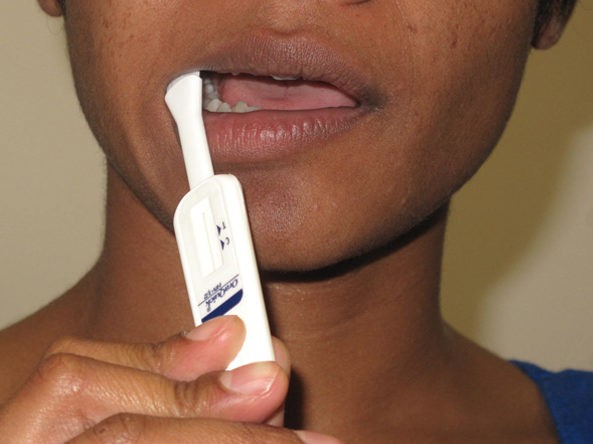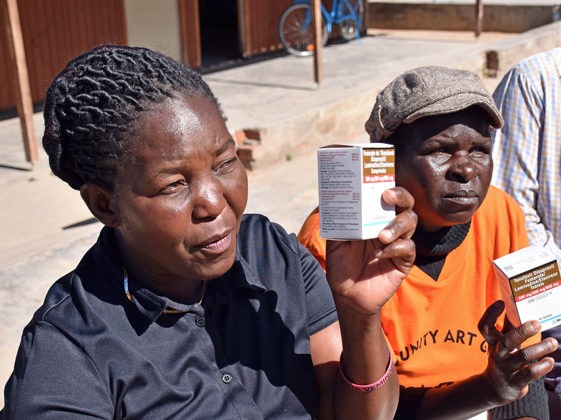Article and Study Summary
Enhanced Prophylaxis plus Antiretroviral Therapy for Advanced HIV Infection in Africa.
Published in:
N Engl J Med 2017; 377:233-245.
http://www.nejm.org/doi/full/10.1056/NEJMoa1615822#t=article
Authors:
James Hakim, Victor Musiime, Alex J. Szubert, Jane Mallewa, Abraham Siika, Clara Agutu, Simon Walker, Sarah L. Pett, Mutsa Bwakura-Dangarembizi, Abbas Lugemwa, Symon Kaunda, Mercy Karoney, Godfrey Musoro, Sheila Kabahenda, Kusum Nathoo, Kathryn Maitland, Anna Griffiths, Margaret J. Thomason, Cissy Kityo, Peter Mugyenyi, Andrew J. Prendergast, A. Sarah Walker, and Diana M. Gibb, for the REALITY Trial Team.
Summary:
This article reports on the open-label, randomized REALITY trial, which compared an enhanced antimicrobial prophylaxis package to standard prophylaxis in individuals with a CD4 count <100 cells per cubic millimeter who were initiating antiretroviral treatment (ART). The enhanced prophylaxis package consisted of trimethoprim-sulfamethoxazole, plus at least 12 weeks of isoniazid-pyridoxine, 12 weeks of fluconazole, five days of azithromycin, and a single dose of albendazole. Standard prophylaxis was trimethoprim-sulfamethoxazole alone. The trial demonstrated a 27 percent reduction in all-cause mortality after 24 weeks and a 24 percent reduction in mortality after 48 weeks for participants receiving the enhanced prophylaxis package. Findings from this study have already been incorporated into the recently-released WHO guidelines for managing advanced HIV disease.
Download full synopsis here or read below.
Discussion Questions:
- How could the results presented in this article inform strategies in the populations that you work with?
- What programmatic challenges do you foresee? Do you have any best practices to share?
Please share your thoughts and experiences with us in the comments section below.
Full Synopsis:
Background and Context
The World Health Organization (WHO) now recommends universal antiretroviral therapy (ART) regardless of CD4 count, recognizing the clinical benefits of early ART initiation. (1) However, it is estimated that 20-25% of patients with HIV in sub-Saharan Africa present for care with severe immunosuppression (CD4 count <100 cells per cubic milliliter) (2), and among this group, approximately 10% die within the first 3 months of ART. (3,4,5) Severe bacterial infections (6,7), tuberculosis (TB) (4,8,9), and cryptococcal infection (10,11), contribute to this high mortality, which can be exacerbated by immune reconstitution inflammatory syndrome (IRIS) after ART initiation. The Reduction of Early Mortality in HIV-Infected Adults and Children Starting Antiretroviral Therapy (REALITY) trial compared three interventions to reduce early mortality in individuals with advanced HIV infection who were initiating ART: food supplementation, additional raltegravir, and an enhanced antimicrobial prophylaxis package targeting dominant pathogens. This paper reports on the results of the enhanced antimicrobial prophylaxis package only.
Study Summary
This prospective, randomized, open-label trial was conducted in Uganda, Zambia, Malawi, and Kenya from 2013 to 2015 to assess the impact of an enhanced antimicrobial prophylaxis package on mortality for individuals with advanced HIV infection who were starting ART. The study enrolled adults and children (five years of age or older), who were ART-naive and had a CD4 count <100 cells per cubic millimeter. Individuals were excluded if they were pregnant, breastfeeding, had received single-dose nevirapine to prevent mother-to-child transmission of HIV, or had any contraindications to the trial drugs.
All participants were initiated on ART with two nucleoside reverse-transcriptase inhibitors and one non-nucleoside reverse-transcriptase inhibitor, and were randomized to receive either enhanced antimicrobial prophylaxis or standard prophylaxis. The enhanced prophylaxis package consisted of a single dose (400 milligrams) of albendazole, five days of azithromycin (500 milligrams once daily), 12 weeks of fluconazole (100 milligrams once daily), and 12 weeks of a fixed-dose combination of trimethoprim–sulfamethoxazole (160 milligrams/800 milligrams), isoniazid (300 milligrams), and pyridoxine (25 milligrams) as a scored once-daily tablet. Doses were halved for children younger than 13 years of age, except for albendazole. Standard prophylaxis consisted of trimethoprim–sulfamethoxazole alone. After 12 weeks, both groups were continued on trimethoprim–sulfamethoxazole and the use of isoniazid and pyridoxine followed national guidelines for isoniazid preventive therapy (IPT). All participants were screened for active TB before randomization using a symptom checklist. Participants were assessed at regular intervals by nurses and physicians, and their symptoms, adherence, and relevant laboratory tests were documented. The primary outcome was death from any cause at 24 weeks. The secondary outcomes included: death from any cause at 48 weeks, adverse events, incidence of opportunistic infections, WHO Stage 3 and 4 events, change in viral load, hospitalizations, and self-reported adherence and acceptability of the regimen.
Study Population and Follow-up
- A total of 1805 individuals were randomized: 906 received enhanced prophylaxis, and 899 received standard prophylaxis.
- Median age was 36 years and 4% were aged 5-17 years.
- Median CD4 count was 37 cells per cubic millimeter and 74% had a viral load >100,000 copies per milliliter.
- Of all patients, 47% were WHO Clinical Stage 1 or 2.
- 3% were lost to follow-up, with no significant difference between the groups.
Mortality Outcomes
- Fewer deaths were reported in the enhanced prophylaxis group compared to the standard prophylaxis group at 24 weeks (8.9% vs. 12.2%, hazard ratio [HR] 0.73, 95% confidence interval [CI] 0.55–0.98, p=0.03) and at 48 weeks (11.0% vs. 14.4%, HR 0.76, 95% CI 0.58–0.99, p=0.04).
- At 24 weeks, 30 participants would need to have received enhanced prophylaxis to prevent one death, and at 48 weeks, 29 participants would need to have received enhanced prophylaxis to prevent one death.
- Significantly fewer deaths were reported in the enhanced prophylaxis group from cryptococcal infection (0.4% vs. 1.5%) and from unascertained causes (3.8% vs. 6.0%).
- Mortality rates peaked at day 18, and this was when the largest absolute difference between the two groups was observed.
Clinical Outcomes (at 48 weeks)
- Participants in the enhanced prophylaxis group had significantly lower rates of:
- WHO clinical stage 3 or 4 events (19.8% vs. 24.9%)
- TB (7.1% vs. 10.2%)
- Cryptococcal infection (1.0% vs. 2.6%)
- Oral or esophageal candidiasis (1.1% vs. 2.6%)
- Hospitalization (17.0% vs. 20.7%)
- IRIS-compatible events (7.4% vs. 12.0%)
- There was no significant difference found between groups in new presumptive severe bacterial infections.
- Enhanced prophylaxis was discontinued in 14 patients (1.5%) due to drug toxicity.
Adherence and Viral Load
- Self-reported adherence to prophylaxis was poorer in the enhanced prophylaxis group during the first 12 weeks; for example, more participants reported missing any dose of prophylactic drugs between weeks 8 and 12 (7.4% vs. 5.2%, p=0.047). From weeks 12 through 48 there was no significant difference in adherence to prophylaxis between the two groups.
- Rates of self-reported adherence to ART and viral suppression were similar in the two groups.
Critical Analysis
This open-label randomized trial demonstrated that an enhanced prophylaxis package, targeting TB, cryptococcal disease, and severe bacterial infections, reduces mortality following ART initiation in individuals with a CD4 count <100 cells per cubic millimeter. This enhanced prophylaxis package was well tolerated and did not affect ART adherence or viral load suppression.
The following points should be considered when interpreting the study findings:
- This was an open-label trial; however, the primary outcome of mortality was objective.
- This study enrolled individuals with a CD4 count <100 cells per cubic millimeter; however, the WHO defines advanced disease as a CD4 count <200 cells per cubic millimeter. Therefore, the benefits of this prophylaxis package remain unclear for individuals with CD4 counts between 100-200 cells per cubic millimeter.
- Although participants in this trial were ART-naive, a substantial number of HIVpatients presenting with advanced disease are returning to care after being lost to follow-up, and may also benefit from this package.
- The study population has a very small proportion of children and adolescents, so the benefits for these groups are less certain.
- As the study tested a package of antimicrobial prophylaxis, it was difficult to quantify the effect of each component.
- Most diagnoses of bacterial infection were presumptive, as many centers lacked microbiologic testing capacity, and cause of death was frequently unknown, as many participants died at home. There was a reduction in death due to unknown causes in the enhanced prophylaxis group; therefore, it is possible that the impact on death related to TB and/or severe bacterial infection was underestimated.
Implications
This study demonstrates the morbidity and mortality benefits of an enhanced antimicrobial prophylaxis package for individuals with advanced HIV disease who are starting ART. Findings from this study have already been incorporated into the recently-released WHOguidelines for managing advanced HIV disease, which recommend initiating IPT, co-trimoxazole and fluconazole after screening for active TB and cryptococcal antigenemia in patients with advanced HIV disease.12 To improve adherence, programs should consider procuring the fixed-dose combination of co-trimoxazole, isoniazid and pyridoxine used in this trial, which has been added to the WHO essential medicine list. This study also highlights the continued need for CD4 testing at the time of ART initiation in order to identify individuals with advanced disease, as almost half of the trial participants were asymptomatic or mildly symptomatic, despite having a CD4 count <100 cells per cubic millimeter.
References
- World Health Organization. Guideline on when to start antiretroviral therapy and on pre-exposure prophylaxis for HIV. Geneva, Switzerland; 2015.
- Avila D, Althoff KN, Mugglin C, et al. Immunodeficiency at the start of combination antiretroviral therapy in low-, middle-, and high-income countries. J Acquir Immune Defic Syndr. 2014;65(1):e8-16.
- Walker AS, Prendergast AJ, Mugyenyi P, et al. Mortality in the year following antiretroviral therapy initiation in HIV-infected adults and children in Uganda and Zimbabwe. Clin Infect Dis. 2012;55(12):1707-1718.
- Gupta A, Nadkarni G, Yang WT, et al. Early mortality in adults initiating antiretroviral therapy (ART) in low- and middle-income countries (LMIC): a systematic review and meta-analysis. PLoS One. 2011;6(12):e28691.
- Boulle A, Schomaker M, May MT, et al. Mortality in patients with HIV-1 infection starting antiretroviral therapy in South Africa, Europe, or North America: a collaborative analysis of prospective studies. PLoS Med. 2014;11(9):e1001718.
- Danel C, Moh R, Gabillard D, et al. A trial of early antiretrovirals and isoniazid preventive therapy in Africa. N Engl J Med. 2015;373(9):808-822.
- Ford N, Shubber Z, Meintjes G, et al. Causes of hospital admission among people living with HIV worldwide: a systematic review and meta-analysis. The Lancet HIV. 2015;2(10):e438-444.
- Gupta RK, Lucas SB, Fielding KL, Lawn SD. Prevalence of tuberculosis in post-mortem studies of HIV-infected adults and children in resource-limited settings: a systematic review and meta-analysis. AIDS. 2015;29(15):1987-2002.
- Ford N, Matteelli A, Shubber Z, et al. TB as a cause of hospitalization and in-hospital mortality among people living with HIV worldwide: a systematic review and meta-analysis. J Int AIDS Soc. 2016;19(1):20714.
- Park BJ, Wannemuehler KA, Marston BJ, Govender N, Pappas PG, Chiller TM. Estimation of the current global burden of cryptococcal meningitis among persons living with HIV/AIDS. AIDS. 2009;23(4):525-530.
- Jarvis JN, Meintjes G, Williams A, Brown Y, Crede T, Harrison TS. Adult meningitis in a setting of high HIV and TB prevalence: findings from 4961 suspected cases. BMCInfect Dis. 2010;10:67.
- World Health Organization. Guidelines for managing advanced HIV disease and rapid initiation of antiretroviral therapy. Geneva, Switzerland; 2017.









